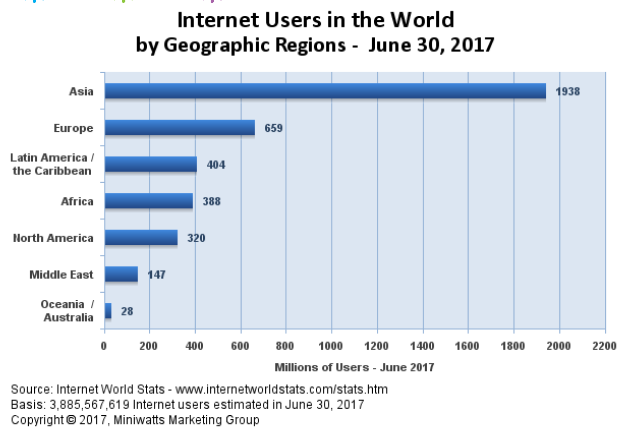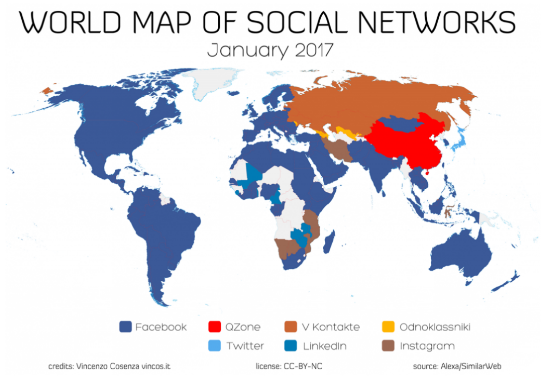19 Feb Managing an International Social Media Presence for Your Craft Business

With the ubiquitous presence of social media, it’s easy to argue that your social media presence should not only include all channels, such as Facebook, Instagram, Pinterest, Twitter and Ravelry but also encompass the widest international reach possible. After all, in our flat global economy, your customers can be from Dubai or Dublin as readily as they are from Delaware. What you might not grasp, however, is the idea that managing an international social media presence means more than just translating posts into different languages. Let’s delve into the why and how of expanding your social program internationally.
Why International?
We all know that social media use is growing exponentially. In June of 2017, we can see in the chart below that users in Asia make up more than double of North America and Western Europe combined. With a total of 3.8 billion users, it’s obvious why you might be considering an expansion of your business beyond American borders.

Managing an international social media presence: Internet users in the world
We know from global digital studies that approximately 14 new users are coming on to the internet every SECOND, and that half the total population are using the internet. Let’s reiterate that again so the point sinks in:
“Over half the world population is using the internet”
Determining the Correct Channels
The first thing to do when taking your brand global is to find out which social media channels the customers you want to reach use the most. While Facebook reached 2 billion users worldwide in June 2017, it’s blocked in China, along with its subsidiaries Messenger and Instagram, as well as Twitter. QZone is the dominant social network there. China’s most popular chat apps combined, WeChat and QQ, have more users in China than Facebook Messenger has around the world. In Russia, it’s VKontakte (VK) and Odnoklassniki (OK). For an overview of the dominant networks worldwide, see Vicenzo Cosenza’s annual World Map of Social Networks; his analysis of second-place platforms throughout the world is enlightening. So your first step is determining which networks are carrying the traffic you want to be part of in the regions you want to reach.

World Map of Social Networks
Just as in the US, different social networks have different audiences and uses within countries and regions. Not only do you have to identify the right networks in a new market, you also have to determine whether those networks are appropriate for your brand. LinkedIn may be popular in sub-Saharan Africa, but if you’re a craft brand trying to reach end consumers, it’s probably not your best channel. Instagram is gaining momentum, and Facebook is also extending its reach, both better suited to marketing to the retail consumer.
Our main piece of advice is to not try to be everything to everyone all at once. Start by targeting one region at a time, on a single social media network, in a country where you have either an e-commerce presence or a physical presence. Once you have established that, you can expand to different regions on the same network or take your campaigns to different platforms within the same region. You can control the rate and direction of your growth based on the strategy you use to manage your international social media presence: global, local, or a hybrid.
Global, Local or In-Between?
As you build your brand across an international marketplace, you can take a top-down approach, developing a centralized marketing message that is then tailored for specific countries or regions. Or if you’d rather, you can work from the bottom-up, creating or hiring local teams that craft a brand strategy specifically for their local markets. The first approach is generally more cost-effective, but you run the risk of having your message misunderstood in different countries.(The iconic example was the relaunched Chevy Nova, which failed in Spanish-language markets, because its model name meant “it doesn’t go”?) .

1969 Chevy Nova
Iconic brands like Coca-Cola or Nike, whose logos and products are instantly recognized around the world, can deliver a single unified message effectively. A small craft brand whose products may be used in entirely different ways in different regions, may find a centralized strategy less effective
A hybrid global-local approach to social media might take a unified central brand message, but employ local translators who post to the most important local social media networks, amplifying your brand’s voice in a culturally responsive manner. The people doing that work for your brand need to both know your products intimately and know the local culture well enough to be able to translate your marketing messages in a way that will engage the local customer base. They are a human bridge between your brand and your potential new market. For a craft business, this might be a more effective approach than the unified global strategy.
Translating Your Brand Message
Let’s use knitting for an example of how a particular craft both unites people with similar interests into a global community, but has significant regional and ethnic variation. Effective social media marketing has to take both of these ideas into account. Not only do you have “English” or “throwing” style vs. “Continental” or “picking” style, there’s “Portuguese” knitting which is also very common in Greece, Turkey, and other areas of the former Ottoman empire. Add Eastern “crossed” and “uncrossed” styles, and any other regional differences in the ways a yarn crafter can produce knitted fabric, and you begin to get the idea that a series of technique videos featuring a set of interchangeable needles could be potentially confusing to different segments of its intended audience. If your intended audience is distracted by the knitting style they see on the video, they are not engaging with the product.
We’ll break down the ways in which that single marketing idea, offering knitting tips and tricks that feature the company’s knitting needles, needs to be modified in order for it to be relevant in different global markets. The breakdown should give you an idea of what you should consider as you take your message international.
- Regional knitting style: Have the knitters in your videos knit in the dominant style of the knitters of the intended market. You can apply this advice to most handwork and textile crafts.
- Regional knitting terminology: How are stitches, rows, increases, decreases and patterning expressed here? Are patterns written out or done in charts? Is that garment a sweater or a jumper? In other words, what is the language of knitting (or your specific craft) in the target market?
- Local/regional language: colloquialisms, idioms, and slang, as well as grammar, vary regionally even within a single language. Canadian English and US English are not the same, particularly in matters of knitting; how you spell fibre/fiber in your hashtags will affect who finds your message. The French you use to reach French-speaking Canadian markets is different from the French you would use to reach French-speaking European markets (which differ amongst themselves as well).
- Units of measurement: Are the units of length and weight metric or Imperial (meters vs. yards, grams vs. ounces)? Are knitting needles assigned sizes in numbers or millimeters? A North American size 8 needle has a 5mm diameter, but a knitter from Europe might read that “size 8” and assume 8mm, which will produce a very different and probably undesired result.
Factoring in all these variations can seem daunting; that’s why social media marketing specialists encourage you to start small as you try to extend your social media presence internationally. Look at where your competitors are both in terms of geography and social media platforms, then pick a single market in which to focus your social media efforts. Bring your original ideas, certainly, but adapt your style of presentation as you account for the factors outlined above, so that your social media posts fit the culture of the customers you are trying to reach. Place your message strategically on the appropriate social media networks in your targeted market. Then assess your results. If customers are engaging with the posts in a natural, responsive manner and not making fun of them or asking for clarifications, then you’re reaching them. Now you can take that message to another network, or modify that campaign for another market.
Culture, Custom, and Policy
Once you have crafted a campaign and had it translated for your social media networks in your targeted markets, you also have to make sure that it meets local customs, policies, and laws for advertising and e-commerce. If your social media posts direct customers to an e-commerce site, is the site translated into the local language? Can it handle currency conversion? Are you charging required taxes and fees and appropriate shipping costs? Is your product priced appropriately for your different markets to account for these different overhead costs? What sort of labeling and customs declarations are required in the country to which you are marketing? Eucalan, a Canadian company, must label their products in both French and English. Are there country-specific limitations placed on the type and amount of information you can retain from visits to your website and how or whether you can follow up those digital leads? Electronic privacy requirements vary around the world, and other countries take violations more seriously and with stiffer penalties than the US does. Again, this is where local experts are worth your marketing budget to make sure that you are in compliance with local regulations.
You can see it’s not enough to load your Tweets into Google Translator and send out the results and consider that an international social media marketing campaign. It’s not impossible, though, to launch your brand into new global markets thoughtfully and sensitively. With careful research in preparation and informed input from on-the-ground local experts in implementation, your craft brand can engage with new customer audiences and grow into a global leader in your craft sector.
Stitchcraft Marketing is a niche agency specializing in craft-centric small businesses. If you’d like more information about anything contained in this article, [contact-form][contact-field label=’Name’ type=’name’ required=’1’/][contact-field label=’Email’ type=’email’ required=’1’/][contact-field label=’Website’ type=’url’/][contact-field label=’Comment’ type=’textarea’ required=’1’/][/contact-form]


No Comments